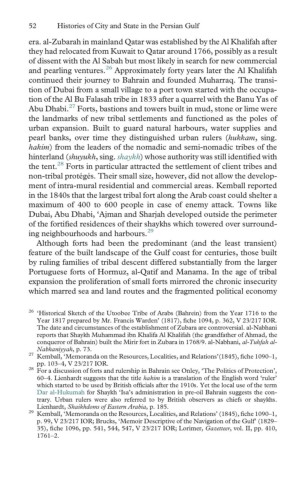Page 72 - Histories of City and State in the Persian Gulf_Neat
P. 72
52 Histories of City and State in the Persian Gulf
era. al-Zubarah in mainland Qatar was established by the Al Khalifah after
they had relocated from Kuwait to Qatar around 1766, possibly as a result
of dissent with the Al Sabah but most likely in search for new commercial
and pearling ventures. 26 Approximately forty years later the Al Khalifah
continued their journey to Bahrain and founded Muharraq. The transi-
tion of Dubai from a small village to a port town started with the occupa-
tion of the Al Bu Falasah tribe in 1833 after a quarrel with the Banu Yas of
27
Abu Dhabi. Forts, bastions and towers built in mud, stone or lime were
the landmarks of new tribal settlements and functioned as the poles of
urban expansion. Built to guard natural harbours, water supplies and
pearl banks, over time they distinguished urban rulers (hukkam, sing.
hakim) from the leaders of the nomadic and semi-nomadic tribes of the
hinterland (shuyukh, sing. shaykh) whose authority was still identified with
the tent. 28 Forts in particular attracted the settlement of client tribes and
non-tribal protégés. Their small size, however, did not allow the develop-
ment of intra-mural resident ial and commercial areas. Kemball reported
in the 1840s that the largest tribal fort along the Arab coast could shelter a
maximum of 400 to 600 people in case of enemy attack. Towns like
Dubai, Abu Dhabi, ‘Ajman and Sharjah developed outside the perimeter
of the fortified residences of their shaykhs which towered over surround-
ing neighbourhoods and harbours. 29
Although forts had been the predominant (and the least transient)
feature of the built landscape of the Gulf coast for centuries, those built
by ruling families of tribal descent differed substantially from the larger
Portuguese forts of Hormuz, al-Qatif and Manama. In the age of tribal
expansion the proliferation of small forts mirrored the chronic insecurity
which marred sea and land routes and the fragmented political economy
26
‘Historical Sketch of the Utoobee Tribe of Arabs (Bahrein) from the Year 1716 to the
Year 1817 prepared by Mr. Francis Warden’ (1817), fiche 1094, p. 362, V 23/217 IOR.
The date and circumstances of the establishment of Zubara are controversial. al-Nabhani
reports that Shaykh Muhammad ibn Khalifa Al Khalifah (the grandfather of Ahmad, the
conqueror of Bahrain) built the Mirir fort in Zubara in 1768/9. al-Nabhani, al-Tuhfah al-
Nabhaniyyah, p. 73.
27
Kemball, ‘Memoranda on the Resources, Localities, and Relations’(1845), fiche 1090–1,
pp. 103–4, V 23/217 IOR.
28
For a discussion of forts and rulership in Bahrain see Onley, ‘The Politics of Protection’,
60–4. Lienhardt suggests that the title hakim is a translation of the English word ‘ruler’
which started to be used by British officials after the 1910s. Yet the local use of the term
Dar al-Hukumah for Shaykh ‘Isa’s administration in pre-oil Bahrain suggests the con-
trary. Urban rulers were also referred to by British observers as chiefs or shaykhs.
Lienhardt, Shaikhdoms of Eastern Arabia, p. 185.
29
Kemball, ‘Memoranda on the Resources, Localities, and Relations’ (1845), fiche 1090–1,
p. 99, V 23/217 IOR; Brucks, ‘Memoir Descriptive of the Navigation of the Gulf’ (1829–
35), fiche 1096, pp. 541, 544, 547, V 23/217 IOR; Lorimer, Gazetteer, vol. II, pp. 410,
1761–2.

